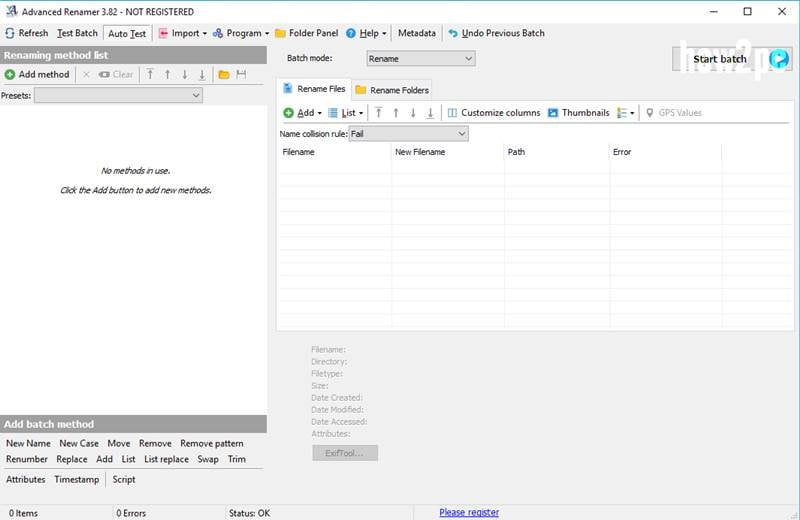

- Windows mass rename based on timestamp for windows 10#
- Windows mass rename based on timestamp code#
- Windows mass rename based on timestamp windows#
In this tutorial, you have learned to create directories or filenames based on the current date time in the Windows system. Also, a file created in the current directory with the name “access_20171102-154136.log” (Filename will be according to current date and time and will change during your testing) Conclusion Type the new name for the file, then press the Tab key on your keyboard. PS: Running this in a command window require replacing all the batch file. Right-click on the first file in the folder, then click Rename. You will find that a directory is created with the name “20171102-154136”. Batch script rename file with date and time Rename file with timestamp cmd. Open a terminal and execute the above batch script.

Set SUBFILENAME=%CUR_YYYY%%CUR_MM%%CUR_DD%-%CUR_HH%%CUR_NN%%CUR_SS% To test this create a file test.bat with the following content. The complete windows batch script will look like below. If your current date time is 15:41:36, then the above example will create a file in the current directory with name “access_20171102-154136.log”. You can use and create any file name as per your requirements like: set SUBFILENAME=%CUR_YYYY%%CUR_MM%%CUR_DD%-%CUR_HH%%CUR_NN%%CUR_SS%Įcho "Welcome Here!" > access_%SUBFILENAME%.log Well suited for those that need to rename many files and/or folders on a regular basis. Now, you have variables having current date and time in variables. Metamorphose is a free, open source program to mass rename files and folders which combines great flexibility with an intuitive interface.A profesional renaming tool for almost any situation, it has many powerful functions. Let’s show you the script, and then explain how it works: strComputer. If %CUR_HH% lss 10 (set CUR_HH=0%time:~1,1%) Now it’s time for the second and final step: renaming each of the files. Now extract the hours, minutes, seconds, and microseconds and store them in variables. Next is to parse the time which is available in 15:41:36.39 (Hours, Minutes, Seconds, and Micro Seconds) format. So use following commands to extract the date in YYYY format, month in MM format and date in DD format and stored in CUR_YYYY, CUR_MM, and CUR_DD variables correspondingly. Windows takes the date in the format like Thu. Let’s go through the tutorial and understand the process to accomplish this. For example, you are writing a script that creates backup regularly, Now you want to organize daily backups with the current date and time name, so it will be easier to identify, which folder containers backups of which date. Make sure folder2 does not exist, neither in d:\path nor in the current folder, or the previous command will really move folder2 into folder1 (making folder2 a subfolder of folder1).This tutorial will help you to create files and directories with the name of the current date-time on the Windows system.

Where folder2 is a folder name only (not a fully qualified path). To get a day of week from a timestamp, use the DAYOFWEEK() function. You can rename folders with the MOVE command: MOVE d:\path\folder1 folder2 To find rows between two dates or timestamps: SELECT FROM events where eventdate. Will rename testfile.txt to testfile.txta. Will rename testfile.txt to tesa, so it seems to mean chop off everything after the last s and then append an a. REN testfile.txt *stĭoes that mean chop off everything after the last occurrence of st? No it doesn't: REN testfile.txt *sa Will not change the name at all (remember: the last occurrence.?). Justin taught me an undocumented REN feature to chop off everything from a file name after the last occurrence of a specified character: REN testfile.txt *s The proper way to do this in NT is: FOR %%A IN (*.txt) DO REN "%%~fA" "%%~nA1.*"įor each *.txt file, "%%~fA" resolves to the (doublequoted) fully qualified path, and %%~nA1 to the original file name only, with a 1 appended, and. Try that in Windows (XP) and you'll get *.txt1.txt files.
Windows mass rename based on timestamp for windows 10#
If I remember correctly, in the old MS-DOS days, it was possible to append characters to the file name using the command: REN *.txt *1.txt Top 10 Best Bulk Rename Utility for Windows 10 in 2021 1. You can even use wildcards in filename1 (and filename2) to rename, say, all your (very) old MS-DOS (ASCII) help files from *.doc to *.txt: REN *.doc *.txt

Windows mass rename based on timestamp code#
You should see code that looks something like this: package com. Don't change/click on anything on first screen just click on 'Next' The second page, click on the 'use template' then click on next 5. Note that you cannot specify a new drive or path for your destination file. Open (if not automatic after install) and click on 'Create New Project' 4.


 0 kommentar(er)
0 kommentar(er)
